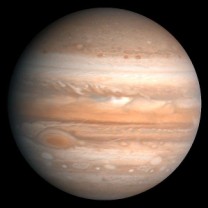Monday, 31 October 2011
 Invisible Ink with Lemon Juice
Invisible Ink with Lemon Juice
Making invisible ink is a lot of fun, you can pretend you are a secret
agent as you keep all your secret codes and messages hidden from others.
All you need is some basic household objects and the hidden power of
lemon juice.
What you'll need:
- Half a lemon
- Water
- Spoon
- Bowl
- Cotton bud
- White paper
- Lamp or other light bulb
Instructions:
- Squeeze some lemon juice into the bowl and add a few drops of water.
- Mix the water and lemon juice with the spoon.
- Dip the cotton bud into the mixture and write a message onto the white paper.
- Wait for the juice to dry so it becomes completely invisible.
- When you are ready to read your secret message or show it to someone else, heat the paper by holding it close to a light bulb.
What's
happening?
Lemon juice is an
organic substance that oxidizes and turns brown when heated. Diluting
the lemon juice in water makes it very hard to notice when you apply it
the paper, no one will be aware of its presence until it is heated and
the secret message is revealed. Other substances which work in the same
way include orange juice, honey, milk, onion juice, vinegar and wine.
Invisible ink can also be made using chemical reactions or by viewing
certain liquids under ultraviolet (UV) light.
Saturday, 29 October 2011
 Meteoroid Facts for Kids
Meteoroid Facts for Kids

- A meteoroid is a small rock or particle of debris in our solar system. They range in size from dust to around 10 metres in diameter (larger objects are usually referred to as asteroids).
- A meteoroid that burns up as it passes through the Earth’s atmosphere is known as a meteor. If you’ve ever looked up at the sky at night and seen a streak of light or ‘shooting star’ what you are actually seeing is a meteor.
- A meteoroid that survives falling through the Earth’s atmosphere and colliding with the Earth’s surface is known as a meteorite.
- The fastest meteoroids travel through the solar system at a speed of around 42 kilometres per second (26 miles per second).
- The Earth’s atmosphere experiences millions of meteors every day.
- Meteors are easier to see during the lower light conditions of night.
- A small percentage of meteoroids fly on a path that goes into the Earth’s atmosphere and then back out again, they are known as Earth grazing fireballs.
- When many meteors occur in a close time frame in the same part of the sky it is called a meteor shower.
- Around 500 meteorites reach the Earth’s surface every year but of those only around 5 ever make it to scientists for study.
- Meteorites that are observed as they fall through the Earth’s atmosphere and later recovered are called ‘falls’, all others are called ‘finds’. To this date there have been around 1000 collected ‘falls’ and 40000 ‘finds’.
- Unsure why a meteoroid is different to meteor, comet or asteroid? Learn the difference between a comet, asteroid, meteoroid, meteor & meteorite.
 Dwarf Planet Facts
Dwarf Planet Facts
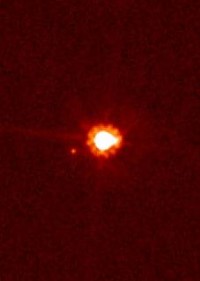 |
What are dwarf planets? Why is Pluto no longer a planet?
Learn the answer to these questions and more with our fun dwarf planets facts for kids.
- In 2006 the International Astronomical Union adopted the term ‘dwarf planet’ forsolar system objects that were bigger than small solar system bodies such ascomets and asteroids but not quite planets.
- The definition of a dwarf planet is an object orbiting the Sun that is large enough to be rounded by its own gravity but is not gravitationally dominant in its orbital area and is not a moon.
- As of 2008, there are five recognized dwarf planets: Pluto, Ceres, Eris, Makemake & Haumea.
- There are a number of other candidates for the status of dwarf planet. Some of these classifications could be resolved as NASA’s Dawn and Horizon missions venture towards Pluto in the coming years.
Pluto
- Pluto hit the headlines in 2006 when it was demoted from a planet to a dwarf planet by the International Astronomical Union. While most astronomers agreed with the new classifications, some disagreed and still refer to Pluto as the ninth planet.
Ceres
Eris
- Eris was discovered in 2005 and was referred to as the tenth planet until it was reclassified in 2006. It is the largest of the dwarf planets.
Makemake
- Makemake was discovered in 2005 and the third largest dwarf planet behind Eris and Pluto.
Haumea
- Haumea was discovered in 2004 and named a dwarf planet in 2008.
 Sun Facts for Kids
Sun Facts for Kids
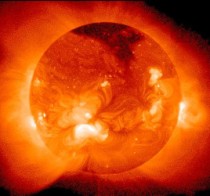
- The Sun is a star found at the center of the Solar System.
- It makes up around 99.86% of the Solar System’s mass.
- At around 1,392,000 kilometres (865,000 miles) wide, the Sun’s diameter is about 110 times wider than Earth’s.
- Around 74% of the Sun’s mass is made up of hydrogen. Helium makes up around 24% while heavier elements such as oxygen, carbon, iron and neon make up the remaining percentage.
- Light from the Sun reaches Earth in around 8 minutes.
- The Sun’s surface temperature is around 5500 degrees Celsius (9941 degrees Fahrenheit), so pack plenty of sunscreen if you plan on visiting (remembering that the average distance from the Sun to the Earth is around 150 million kilometers).
- The Sun’s core is around 13600000 degrees Celsius!
- The Sun generates huge amounts of energy by combining hydrogen nuclei into helium. This process is called nuclear fusion.
- Because of the Sun’s huge influence on Earth, many early cultures saw the Sun as a deity or god. For example, Ancient Egyptians had a sun god called Ra while in Aztec mythology there is a sun god named Tonatiuh.
- The Sun produces a solar wind which contains charged particles such as electrons and protons. They escape the Sun’s intense gravity because of their high kinetic energy and the high temperature of the Sun’s corona (a type of plasma atmosphere that extends into space).
- Planets with strong magnetic fields such as Earth manage to deflect most of these charged particles as they approach.
- A solar eclipse occurs when the Moon is between the Sun and the Earth.
 Moon Facts for Kids
Moon Facts for Kids
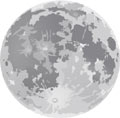
- It is the fifth largest moon in the Solar System. Learn more about the othermoons in the Solar System.
- The average distance from the Moon to the Earth is 384403 kilometres (238857 miles).
- The Moon orbits the Earth every 27.3 days.
- Mons Huygens is the tallest mountain on the Moon, it is 4700 metres tall, just over half the height of Mt Everest (8848m).
- The Moon rotates on its axis in around the same length of time it takes to orbit the Earth. This means that from Earth we only ever see around 60% of its surface (50% at any one time).
- The side that we can see from Earth is called the near side while the other side is called the far side (it is sometimes called the dark side despite the fact that it illuminated by the Sun just as much as the near side).
- The effect of gravity is only about one fifth (17%) as strong on the surface of the Moon compared to the strength of gravity on the surface of the Earth.
- The Soviet Union’s Luna program featured the first successful landing of an unmanned spacecraft on the surface of the Moon in 1966.
- The USA’s NASA Apollo 11 mission in 1969 was the first manned Moon landing.
- The first person to set foot on the Moon was Neil Armstrong.
- The far side of the Moon looks quite different due to its lack of maria (ancient pools of solidified lava).
- The surface of the Moon features a huge number of impact craters from cometsand asteroids that have collided with the surface over time. Because the Moon lacks an atmosphere or weather these craters remain well preserved.
- Although research is continuing, most scientists agree that the Moon features small amounts of water.
- The Moon is very hot during the day but very cold at night. The average surface temperature of the Moon is 107 degrees Celsius during the day and -153 degrees Celsius at night.
- The Earth’s tides are largely caused by the gravitational pull of the Moon.
- The phases of the Moon are: New Moon, Crescent, First Quarter, Waxing Gibbous, Full Moon, Waning Gibbous, Last Quarter, Crescent, New Moon….
- A lunar eclipse occurs when the Earth is between the Sun and the Moon.
 Asteroid Facts for Kids
Asteroid Facts for Kids

- Asteroids are small Solar System bodies that orbit the Sun. Made of rock and metal, they can also contain organic compounds (some scientists suggest that asteroids could have brought they necessary chemicals to start life on Earth).
- Asteroids are similar to comets but do not have a visible coma (fuzzy outline and tail) like comets do.
- Asteroids are also known as planetoids or minor planets.
- Asteroids vary greatly in size, some feature diameters as small as ten metres while others stretch out over hundreds of kilometres. Note that objects under ten metres in diameter are generally regarded as meteoroids.
- The first asteroid was discovered in 1801 by Italian astronomer Giuseppe Piazzi. Named Ceres, it features a diameter of around 950 kilometres and is now regarded as a dwarf planet. Ceres was given dwarf planet status in 2006, along with Pluto, Eris, Makemake and Haumea.
- The asteroid belt lies roughly between the orbits of Mars and Jupiter in the Solar System. It is home to a large amount of irregular shaped asteroids that range in size from dust through to the dwarf planet Ceres.
- The technology used for discovering asteroids has improved dramatically since original discoveries and astronomers now have access to a range of powerful telescopes to aid in their research and discoveries.
- It is believed by many scientists and researchers that an asteroid impact was the cause behind the extinction of the dinosaurs around 65 million years ago.
- The possibility of an asteroid colliding with Earth has received increased attention over recent years. The Shoemaker-Levy comet that collided with Jupiter in 1994 were given widespread media coverage and Hollywood also played its part with moves such as Deep Impact (1998) and Armageddon (1998). While these movies sometimes featured dubious science they certainly increased public awareness of the topic.
- There are now many groups and organizations that use automated systems to discover near Earth asteroids. While many are discovered, they rarely have the potential to cross paths with Earth.
- There have been many ideas suggested as ways to avoid the unlikely but potentially devastating impact of an asteroid collision with Earth, these include using nuclear explosions to break the asteroid into smaller pieces or other weapons to deflect it off course.
 Comet Facts for Kids
Comet Facts for Kids
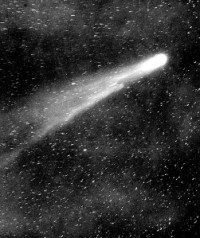
- A comet is a relatively small solar system body that orbits the Sun. When close enough to the Sun they display a visible coma (a fuzzy outline or atmosphere due to solar radiation) and sometimes a tail.
- The coma is created as the comet gets closer to the Sun, causing water, carbon dioxide and other compounds to sublime (quickly changing from solid to gas) from its surface.
- Comets are made of ice, dust and small rocky particles.
- The name comet comes from the Greek word meaning ‘hair of the head’, it came from the Greek philosopher Aristotle who observed comets as ‘stars with hair’.
- Short term comets (also known as periodic comets) have orbital periods of less than 200 years while long term comets have orbital periods of over 200 years.
Halley's Comet
- Halley’s Comet (or Comet Halley as it is also known) is the most well known comet.
- It is known as a periodic comet (or short term comet) because the time it takes to orbit the Sun is less than 200 years.
- Records of humans observing Halley’s Comet go back thousands of years, with appearances noted by Babylonian, Chinese and European star gazers.
- It can be seen with the naked eye from Earth every 75 to 76 years (although the time period has between 74 and 79 years in the past).
- It last appeared in the inner Solar System in 1986 and will return again sometime in 2061 (start charging your camera battery).
- Halley’s Comet is named after English astronomer Edmond Halley who first determined its period of orbit. It was the first comet to be recognized as having a periodic orbit.
- Halley’s Comet appearance in 1986 allowed researchers to investigate its make up more closely using spacecraft. While some previous theories were proven correct, other models were altered with the new information. For example, while earlier models predicted the comet to feature many volatile ices, the actual amount was less than first expected.
- The tail and fuzzy glow you see around Halley’s Comet is known as a coma. It occurs when the comet gets close to the Sun and compounds such as frozen water and carbon dioxide sublime (rapidly change from solid to gas) from its surface.
- While the coma over Halley’s Comet can stretch up to 100,000 km across, the nucleus is actually small, only around 15km (9.3 miles) long, 8km (5 miles) wide and 8km (5 miles) thick.
Comet Shoemaker-Levy 9
- In July 1994, the Shoemaker-Levy 9 comet broke apart and collided with Jupiter. This event gave astronomers a unique opportunity to observe what happens when such a collision occurs.
- The largest fragments were 2 km (1.2 mi) in diameter and struck Jupiter at a speed of around 60 km/s (37 mi/s). The impact scars were clearly visible for months after the impact.
- Shoemaker-Levy 9 was originally located by astronomers Eugene M. and Carolyn Shoemaker and David Levy in March 1993.
Friday, 28 October 2011
 Pluto Facts for Kids
Pluto Facts for Kids
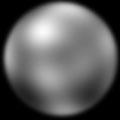
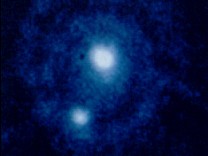
- Pluto was the smallest and furtherest planet from the Sun in our solar system, now it is not even officially recognized as a planet!
- In 2006 Pluto was demoted to the status of dwarf planet.
- Because it is so far away from the sun it is very cold with temperatures ranging form -235 Degrees Celsius to -210 Degrees Celsius.
- Pluto consists of rock with a very thick coating of ice.
- The atmosphere of Pluto consists of nitrogen with some carbon monoxide and methane.
 Neptune Facts for Kids
Neptune Facts for Kids
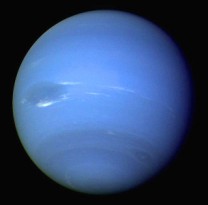
Neptune is a large planet that experiences extreme atmospheric weather conditions.
After the demotion of Pluto, it now holds the distinction of being further away from the Sun than any other planet in our Solar System.
- Neptune is a large planet, nearly four times the size of Earth.
- Neptune suffers the most violent weather in our Solar System.
- Storms have been spotted swirling around its surface and freezing winds that blow about ten times faster than hurricanes on Earth make it the windiest planet.
- Neptune is a large, water planet with a blue hydrogen-methane atmosphere and faint rings.
- Neptune is covered in thin wispy white clouds which stretch out around the planet.
 Uranus Facts for Kids
Uranus Facts for Kids

Uranus likes to be a bit different. It shows off a majestic blue/green haze due to its high levels of methane gas and rolls like a barrel rather than spinning like Earth and other planets in our Solar System.
- Uranus spins lying on its side (like a barrel), this is perhaps due to a large collision early in its formation.
- Uranus was the first planet discovered by telescope.
- Since Uranus takes 84 Earth years to go around the sun, this means that each of its poles is in daylight for 42 years and in darkness for the next 42.
- Uranus’s atmosphere is mostly hydrogen but it also contains large amounts of a gas called methane. Methane absorbs red light and scatters blue light so a blue-green methane haze hides the interior of the planet from view.
- Uranus hides its interior but scientists guess that under the hydrogen-methane atmosphere is a hot, slushy ocean of water, ammonia and methane thousands of miles deep wrapped around a rocky core.
 Saturn Facts for Kids
Saturn Facts for Kids
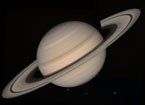
|
Monday, 24 October 2011
 Jupiter Facts for Kids
Jupiter Facts for Kids
Jupiter is the largest planet in
our solar system. Its famous 'Red Spot' and raging gas storms give it an
impressive if not intimidating appearance.
As well as having many
moons, Jupiter also has a number of rings similar to that of Saturn but
much less noticeable.
-
Jupiter is the largest planet in our Solar system. It is so big that more than 1300 Earth's could fit inside it.
- Thick, colorful clouds of deadly poisonous gases surround Jupiter. The quick spinning of the planet whips up the atmosphere, creating the bands around the planet.
- If you were to descend into Jupiter, the thin, cold atmosphere becomes thicker and hotter, gradually turning into a thick, dark fog. In the blackness about 1000km down the pressure squeezes the atmosphere so hard that it becomes like liquid.
- At the centre of Jupiter is a rocky core, slightly bigger than Earth but weighing about 20 times more.
- Surrounding the core is an ocean of liquid hydrogen, about 1,000 kilometres deep.
- Jupiter has many storms raging on the surface, most notably the big red spot which is the largest hurricane in our Solar System. It's been raging for over three hundred years.
- Jupiter has a very strong magnetic field, you would weigh two and a half times as much as you would on earth.
- Jupiter has many moons circling around it. Four of these moons are bigger than Pluto.
Friday, 21 October 2011
 Mars Facts for Kids
Mars Facts for Kids
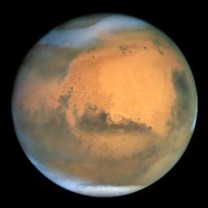
Mars, or the 'Red Planet' as it is sometimes known, has a dusty, rocky surface and a thin atmosphere. Its relatively calm conditions and close proximity to earth make it the most likely destination for future planet exploration by humans.
It has already been visited by a number of Mars Rovers in successful (and unsuccessful) robotic missions. These highly advanced robots gather samples and record important scientific data for scientists back on Earth to study.
- Mars is nicknamed the red planet because it is covered with rust-like dust. Even the atmosphere is a pinkish red, colored by tiny particles of dust thrown up from the surface.
- Mars experiences violent dust storms which continually change its surface.
- Mars has many massive volcanoes and is home to Olympus Mons, the largest volcano in our solar system, it stands 21km high and is 600km across the base.
- Mars has a very thin atmosphere made mostly of carbon dioxide. It is not thick enough to trap the sun's heat like Venus, so the planet is very cold. Temperatures range from -120 Degrees Celsius on winter nights to 25 Degrees Celsius in the summer.
- Mars has many channels, plains and canyons on the surface which could have been caused by water erosion in the past.
- Mars has very weak gravity which cannot hold onto the atmosphere well.
- The polar ice caps consist of frozen Co2 (dry ice) which lies over a layer of ice.
Wednesday, 19 October 2011
 Venus Facts for Kids
Venus Facts for Kids
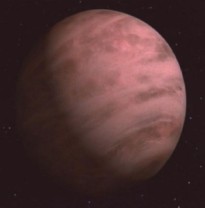
Venus is a fascinating planet that is similar in size to Earth but very different in regards to atmosphere and surface conditions.
Its thick clouds lock in the heat while the surface rages with active volcanoes.
- The atmosphere of Venus made up mainly of carbon dioxide.
- Its size is slightly smaller than Earth.
- It also features gravity similar to that of Earth.
- Venus is surrounded by clouds consisting of mercury, ferric chloride hydrocarbons and sulphuric acid. These clouds create the most corrosive acid rain found anywhere in our solar system.
- The clouds are so thick that little light even reaches the surface. The light that does reach the surface is converted to heat and can not escape the atmosphere making Venus the hottest planet at around 500 Degrees Celsius.
- The surface of Venus is often described as a "stormy desert" full of many craters and very active volcanoes.
- The surface is also likened to molten lead.
- Venus features no liquid water.
Monday, 17 October 2011
 Mercury Facts for Kids
Mercury Facts for Kids
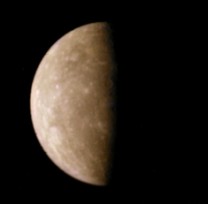
Mercury is a small planet which orbits closer to the sun than any other planet in our solar system.
As well as being very hot, it features a barren, crater covered surface which looks similar to Earth's moon.
- The surface of Mercury is very similar to our moon. It has a very barren, rocky surface covered with many craters.
- Being so close to the Sun, the daytime temperature on Mercury is scorching - reaching over 400 Degrees Celsius.
- At night however, without an atmosphere to hold the heat in, the temperatures plummet, dropping to -180 Degrees Celsius.
- Mercury has a very low surface gravity.
- Mercury has no atmosphere which means there is no wind or weather to speak of.
- There is also no water on the surface of Mercury, it is possible however that there could be water underneath the surface.
- Likewise, there is no air on the surface but it could be trapped underneath.
Saturday, 15 October 2011
 Solar System
Solar System
- The solar system includes the Sun and all the objects that orbit around it due to its gravity. This includes things such as planets, comets, asteroids, meteoroids and moons.
- The Solar System formed around 4.6 billion years ago.
- There are eight planets in the Solar System. The four inner planets are Mercury, Venus, Earth and Mars while the four outer planets are Jupiter, Saturn, Uranus and Neptune.
- The inner planets (also known as terrestrial planets) are smaller and made mostly of rock and metal.
- The outer planets (also known as gas giants) are much larger and made mostly of hydrogen, helium and other gases.
- As of 2008, there are also five dwarf planets: Pluto, Ceres, Eris, Makemake & Haumea.
- There is an asteroid belt which lies between the orbits or Mars and Jupiter, it features a large number of irregular shaped asteroids.
- For thousands of years humans were unaware of the Solar System and believed that Earth was at the center of the Universe.
- Astronomers such as Nicolaus Copernicus, Galileo Galilei, Johannes Kepler and Isaac Newton helped develop a new model that explained the movement of the planets with the Sun at the center of the Solar System.
- The Sun contains 99.86 percent of the Solar System's known mass, with Jupiter and Saturn making up making up most of the rest. The small inner planets which include Mercury, Venus, Earth and Mars make up a very small percentage of the Solar System’s mass.
Thursday, 13 October 2011
 What Causes an Eclipse?
What Causes an Eclipse?
An eclipse occurs at those times when the Moon moves into a position of direct alignment with the Sun and the Earth. There are two basic types of eclipses – lunar and solar. Most people have seen at least one total lunar eclipse, when the full Moon passes through the shadow of the Earth. In this case, the Sun and the Moon are on opposite sides of the Earth. If you observe a lunar eclipse (visible only at night at the time of certain full Moons), you’ll see the bright lunar disk turn dark -- sometimes a coppery red color -- for as long as an hour or more.
But the gentle beauty of a lunar eclipse pales in comparison with the truly awesome spectacle of a total solar eclipse, which occurs when the new Moon passes directly between the Sun and the Earth. In the narrow path of totality swept across the Earth by the Moon’s complete shadow (the umbra), daytime briefly turns to an eerie darkness, and during these few precious minutes the wispy halo of the Sun – the corona –comes into view as the dark disk of the Moon totally obscures the bright Sun. Outside the path of totality, in the Moon’s partial shadow (the penumbra), some portion of the Sun’s bright disk remains visible.

Not all solar eclipses are total. During a partial solar eclipse, only the penumbra touches our planet. The umbra passes either just above the North Pole or just below the South Pole, completely missing the Earth. No total eclipse is visible -- only partial phases can be seen.
A third type of solar eclipse occurs when the Moon's umbra passes across the Earth, but is not quite long enough to touch the surface; the shadow cone diminishes to a point before reaching the Earth. This effect happens when the Moon is farther out in its orbit around the Earth. The Moon appears slightly smaller and is not large enough to completely cover the Sun. When the Moon is centered over the Sun, a ring of sunlight remains visible around the edge. This type of eclipse is called an annular eclipse. (Annular comes from the Latin word meaning "ring.") Because the Sun is not completely covered by the Moon, the rare and dramatic effects of a total solar eclipse (onset of darkness and view of the corona) are not present at either annular or partial eclipses of the Sun. (See Effects During a Total Solar Eclipse.)
Why is a total solar eclipse such a rare event? First of all, eclipses do not occur every month during a new Moon or a full Moon. This is because the orbit of the Moon is tilted by about five degrees with respect to the Earth’s orbit, so that usually the Moon passes slightly above or below the line between the Sun and the Earth. Thus at most new and full Moons, the shadows miss their mark and no eclipse occurs. Only about every six months, during an eclipse season, are the conditions right for a lunar or solar eclipse. (See Patterns of Eclipses.)
And even though solar and lunar eclipses occur with comparable frequency, it is still far more commonplace to experience a lunar eclipse. That’s because the darkened full Moon can be seen from anywhere on the nighttime half of the Earth during the eclipse. To see a total solar eclipse, you have to be in the path of totality. This path, sometimes up to 200 miles wide, never covers more than roughly one-half of one percent of the Earth's surface and often traverses open seas or remote regions of the planet. With fewer than 70 total eclipses per century, the chance to see one is for most of us a once-in-a-lifetime event.
It is quite remarkable that total solar eclipses even occur at all. They are possible because the Sun and the Moon appear from Earth to be about the same size in the sky. The Sun, whose diameter is 400 times that of the Moon, happens to be about 400 times as far away from the Earth. This condition permits the Moon to just barely cover up the Sun. In fact, if the Moon's diameter (2,160 miles) were just 140 miles less, it would not be large enough to ever completely cover the Sun -- a total solar eclipse could never happen anywhere on Earth!










